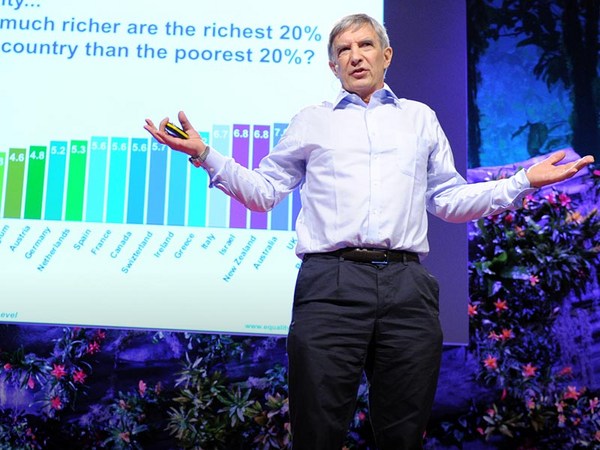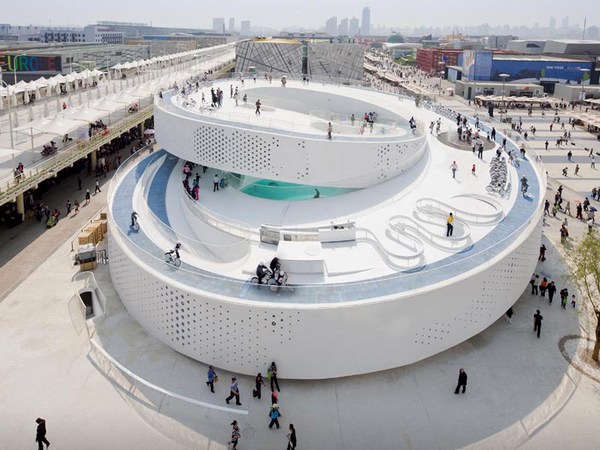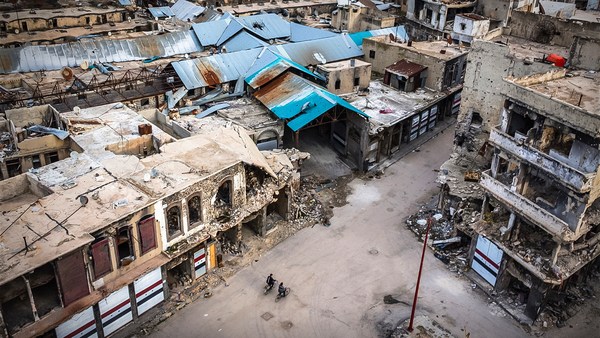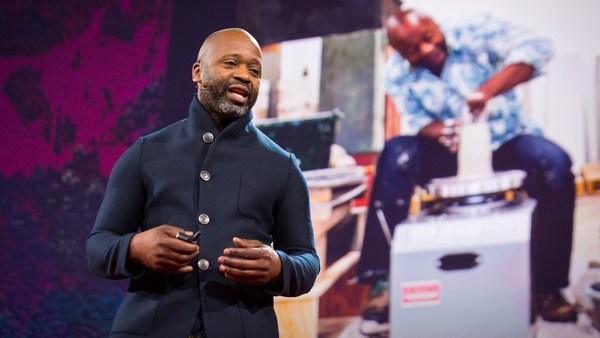We've been asked to address the theme of changing conversations. And I think certainly in the field that I'm in, that's a really important point to be at. From the discourses that are going on within architecture as well as throughout society, I think it is time to change the way that we look at things. As an architect, I've been involved with architectural projects, with urban planning projects, and more recently, projects that engage much more with the landscape. Now I can see so many opportunities and so many ways in which design can contribute and has the capacity to effect social change. And that's what I'm going to talk to you today about.
Starting off, I think it might be useful to talk a little bit about architecture, because I think for many people, architecture is a slightly mystical activity. Not many people know what architects do. A lot of the time, I'm not sure the architects know what they're doing. But we try, and it's important to try and embrace that and try and understand what that means. When I talk about architecture today, I'm not talking about the profession. I'm not talking about an activity that's pursued by a select group of people with some specialized knowledge. I'm talking about architecture in the bigger sense: architecture in terms of the room that we're in, architecture as a pervasive activity, architecture as the activity that is the creation of shelter, the creation of space, the design and the creation of spaces between buildings, the landscape. It's man's interaction with the landscape. Our construction of the built environment -- that's what I mean by architecture. It's not a specialized thing.
And over the last, I suppose, 20 or 30 years, with the predominance of the internet and the wonderful and exciting advancements that are taking place in technology, one of the things that has happened is that our perception of the world has become commodified. It's become reduced in many ways to a perception that is two-dimensional. We spend a lot of our time, a lot of our lives, looking at the world through screens, whether it's our laptops or television screens or monitors at airports or in the workplace or even our telephones are now screens. And it has this effect of reducing our perception of the world. It expands it in many ways, but it can reduce it, it can turn into icons our idea or our notion of certain concepts or ideas that are, in fact, maybe a lot more pervasive than the two-dimensional image can convey. And I think that's true about architecture. I think we've grown accustomed to thinking about architecture in a really primarily two-dimensional way, in a flat way, that the building is about what it looks like, how it appears, it's visual commodity.
But it's much more than that. It's much more than an aesthetic or just a sensory experience. That's very important, but it's much more than that. It's a complex operation. And a big part of architecture and a big part of design involves understanding the context in which that design exists or in which it's going to exist. It's having the imagination to try and predict or project where the building or where the urban space or where the landscape is going to be located, how it's going to be used, what are the operations, what are the activities that are going to take place in that space. And you might call those the programmatic aspects of architecture, the programmatic aspects of design. And I think that in recent times, we've tended to privilege or put at a higher level that visual sensory perception or desire about architecture ahead and in advance of those programmatic needs. We've tended to kind of create monuments, create icons that create a sensation or create effect, without really thinking through the value of the operation that those places or those spaces can affect. And it's in that zone or in that area that I think we need to start looking or trying to understand how architecture or how design can really impact on society, and how it can address some of the problems that we're facing.
The big buzzword in design and in what I do and I think what everybody does is the idea of sustainability. Sustainability is an idea, a notion or a concept that's triangulated by three very important concepts or ideas: the environment, the economy and society. Well, the global economy seems to be currently in a kind of meltdown situation. A lot of work needs to be done there. The environment that we live in is challenged. We've got global warming, we've got rising tides, we've got all sorts of disasters taking place, all sorts of things happening that threaten the equilibrium of the world and the environment that we live in. And society itself is also challenged and threatened by some of the issues that we're faced with. I think we've heard about some of those issues today and the need to change the paradigm in which we perceive those things. It's really very crucial that we do that.
So how does design impact that? How can how can I, as a designer, or anybody as a designer or any architect or how can society -- in what way can design impact on that, in what way can it affect that? I'm going to talk today about ways in which I think design can impact on society, very specifically on society, and how that idea of design can infiltrate the idea of society and work with society in the operations of society in this programmatic way to effect social change. This is an image of Frederick Street in the early part of the last century. And I think it's a good image in lots of ways. It seems like that little triangulation of the environment, the economy and society seems to be in a kind of balance. So it seems that in cities we can see that balance that cities are symbols or ciphers or ways in which we can we can understand the confluence of those forces.
And through time, there have been times when cities have done that very successfully. There are lots of examples of very good cities which have found themselves at a specific moment in time at a point of balance or equilibrium. If we look at Port of Spain as a city, and we consider the idea that, once upon a time, Port of Spain was just a little cluster, a little fishing village at the mouth of the St. Ann's River. And yet it's grown to be such a big, complex conglomeration, a big conurbation of lots and lots of complex ideas.
The Italian architect Aldo Rossi, a 20th-century architect who died at the end of the last century, made a very profound statement. He said architecture is the making of the city over time. I think that's a great statement, because it talks, on one level, about the individual production and manufacture of an object -- architecture -- and it talks about architecture as being a form of cultural production, as something that speaks to an issue or speaks to ideas that are bigger than the sum of the parts of the building, and it relates it to the city.
It also suggested that it's a constant, dynamic, changing process. And I think that's a very important thing to understand, that it's also part of the program. It's nothing to do with visual, it's to do with the program. It's how does this evolve, what are the dynamics, what are the components, what are the elements that contribute to the unraveling and the creation of the city? It also speaks to the fact that the city is something that can be imagined. In the same way as we can conceive and imagine of a space or a building, we can conceive and imagine of a city. And it speaks to the idea of the individual and the collective. And it's that link -- the individual to the collective, the idea of the civitas, the idea of the society -- that I think is a really important axiom for understanding how design can infiltrate and how design can effect change.
These are some images of how Port of Spain evolved over a relatively short period of 200 years, from a colonial plan that was developed following some ordinances sent out by the king of Spain, called the Laws of the Indies. Many cities in the Caribbean and Latin America were predicated and formulated on this. It was a gesture, it was a single design that addressed the needs and the requirements of those establishing cities and new colonies. And it expanded, and over time, as trade began to develop in Trinidad, the city expanded, and it grew, and it started appropriating, more and more, the surrounding landscape, until it grew to pretty much what we have today, or what we understand to be the city of Port of Spain.
But as we all know, that process grew also on a kind of macro scale as well. We have the evolution and the development of this big conurbation that stretches from Port of Spain to the west and over to Arouca in the east and seems to be continuing. So we've developed into this concept or idea that far exceeds the original Laws of the Indies plan. And it's turned into a complex arrangement and matrix of infrastructures and complex issues, issues that, in many ways, have led to a lot of problems. They've led to a lot of infrastructural problems. And we share this with many, many cities in the world. Cities all over the world are expanding, they're increasing, they're undergoing the same type of development that we've undergone to the point where the original Port of Spain and the downtown Port of Spain that used to comprise the city, used to constitute the city, has now turned into this sort of megalopolis, this sprawl, and it's difficult to comprehend. And when we think of the problems, we think of the infrastructural problems: the water, the power, the traffic congestion, the crime, the segregation, the polarization that exists, the situation that has led to what's happened in this country recently with the state of emergency ... Sometimes it seems completely insurmountable. It seems like we've got to a point where we can't really control it in the way that we can control that original plan. We can't really control this anymore. It's almost as if we're victims of the city, rather than people that have willingly or willfully designed the city or formulated the city.
Another phenomenon that has happened commensurate with these issues of size and scale of infrastructure is the predomination of what I would call "typologies," different types of development. We're all familiar with the high-rise development. This is some buildings in Hong Kong, you know, the magnificent, tall structures that cost a fortune to build. But they predominate; it's almost as if you can't have a city unless you've got a high-rise building in it. They're symbolic, they seem emblematic with modernity and development. And then shopping malls is another predominant type, another prevalent type that all cities want to have, the idea that you can concentrate all these shops and all this retail activity in one place and create an environment for people to come and do specific retail functions and purchase things and be in a specific place at a specific time. And then the highway, the idea of cutting through landscapes to create how it's to increase the speed with which we can get from one point to another. And then we also have suburban development. These are all typologies that are emblematic of the type of development that has taken place in modern cities, in Port of Spain and cities all over the world.
Now, there's nothing wrong with shopping malls, there's nothing wrong with highways, and there's nothing wrong with high-rise buildings or suburban development. What is kind of wrong is that what we seem to be doing is privileging types or ways of building or ideas about building above other really very important ways of how we can conceive or how we imagine space. What about schools? What about parks? What about making streets that are really comfortable to walk on and the people are not confronting traffic noise and congestion all the time? Where is that in the equation?
It seems that with our focus on these types of structures and these typologies, which are motivated and driven primarily because they generate profit, they're part of an economic consumer system, they generate profit, that's why they're favored, that's why they are privileged above other types of development. But schools, parks, elements of cities that used to be really significant and really important are being diminished and marginalized as a consequence of the focus on this type of development. They're undermining the integrity of the city, they're undermining the capacity of the city to accommodate social interaction, to accommodate everybody, because the other thing is they're also exclusive. To work in a high-end office, you need to be qualified, you need to be educated, or you need to have access or the resources to get the qualifications or the training that allow you to get the job in there. If you don't have those, you work outside somewhere. We're not concerned about what those places are like, you just go and work somewhere else.
Similarly, those people that used to live in the cities or used to live and contribute to the life of cities are being pushed out because buildings like high-rise buildings push them out. There's a premium on land price that pushes people out of cities. People can't go to shopping malls unless they've got cars, because those malls are generally located on the peripheries of cities. People can't go buy things in shopping malls, because they don't have enough disposable income; they're not going to spend money there. So those types of buildings, whilst they work for sectors of society, don't work for everybody. They're not equitable. Yet, an undue amount of attention is paid by government, by society on ensuring that those types of buildings proliferate, because they're seen as positive aspects of development -- at the expense of types of building and types of program that could be beneficial to everybody, types of program that encourage interaction, that encourage education, that encourage people to be with each other and encourage a sense of community. These types of development dissipate society, they disaggregate society, they polarize society. They create isolated groups of activity to which access depends upon how much money you've got in your pocket. It's a polarizing and negative force. We see it in this city, and we're seeing it more and more other cities.
And what ends up happening is that we end up with this sort of stack, that's like a time bomb. At some point the system must collapse, it's really not sustainable. It's like the economic system in the world today -- it's really not a sustainable system, and we have to find ways of addressing it. Design can't provide the solution, but what it can address is some of the conditions that people live with. It can address some of the circumstances in which people find themselves, some of the areas of cities to which people have been shunted or pushed aside because they can no longer afford to live in the center, and they can't participate actively or fully in this consumerized, capitalized system. And we need to try and conceive of how we can transform these types of spaces, how we can integrate the activities that happen in these types of spaces within a bigger picture, how we can identify small moves or small gestures, whether through design or economic initiative or social initiative that effect change and that allow transformation of spaces that encourage and facilitate greater participation. And there are lots of ways of doing that. And whilst it might seem complex when we look at cities, when we look at the aggregate parts of cities, it may seem insurmountable. But if we try and isolate individual acts, individual ways of looking at things and formulate a program, a manner or way of understanding how we can do that, then we can get nearer to achieving or effecting some kind of social change.
And there are examples in the world where that's been done. Barcelona is a really good example of a city where people sat down and collectively and actively tried to conceive of ways in which they could effect change, and they did it very successfully. And nearer to home, in Bogotá, Enrique Peñalosa, the mayor of Bogotá, when he took office, he decided, "I'm not going to spend billions of dollars on creating more highways. I'm going to appropriate the funds I have, and I'm going to create places -- parks that everybody can use, public spaces that people can use." And as he created, more and more people came into those spaces. And those spaces were very effective in encouraging participation, encouraging senses of community amongst people, getting people to come together to forget what little trifling contests they had between each other, to start doing things together, to start moving around the city together and try to start acting together.
So there are ways of doing it; there are models. And it comes back to this idea of program. What's our program? Well, I think we want to create equitable society. Then we want to create societies where there's active and equitable participation for everybody and where we can break down some of those inhibitions, those barriers. We can remove economic stigma, we can remove stigma around race, around where you live, around all those factors and try and bring people together in constructed and effective ways. In Trinidad, there are a number of examples. There are opportunities to do this all over the place.
This is City Gate. It's the entrance to the city for tens of thousands of people. People come in and out of it every day. And yet, what they're confronted with is pretty bleak, horrid, grey, unwelcoming and sometimes unsafe because of all the traffic zooming around. And that space from City Gate that moves up to Independence Square could be a really wonderful experience, you know, with landscaping, with proper accommodation of the sort of facilities and amenities that people would need and would enjoy. It could become a really very important civic space.
This is the Prado in Havana. It's just a notional idea of how that space could be treated so that movement in and out of the city every day becomes a really important and uplifting transition from the maxi taxi to the place where you work. In San Fernando we've got the waterfront, which is a really very beautiful part of this landscape in this country, but is in complete neglect. There are some really beautiful, fine examples of 19th-century architecture that form, in and of themselves, some really fine spaces.
We need to we need to look at those spaces, we need to appropriate them, we need to determine uses for those spaces that would encourage all types of activity: spaces for performance, spaces for children to play in and learn that it's cool and it's OK and it's fun to be around other people, spaces for people to do all the kinds of activities that people like to do, that they enjoy doing collectively and that benefit society and encourage people to interact, regardless of their social or economic circumstance, or places for people to reflect, parks, places for people to sit and relax. And there are lots of ways we can do that, ways in which we can address and look at how we break down those barriers. We can do it with architectural language. We can look at the ways that spaces are formulated to break down divisions and barriers between inside and outside, between green and hard surfaces and try and generate spaces that really encourage interaction, encourage people to do things together and encourage a sense of community. We need to mandate government, we need to provide examples to developers, to people to generate that the benefit of these may not be measured in a financial return on investment, but the social benefit to us all is really immeasurable in the long run.
And if we do that, I think we can demonstrate -- and we've demonstrated in the past that designers had the capacity to do that -- I think if we can do that, we can demonstrate to people that society is an inclusive community, and that if everybody is included, and if everybody feels part of the society, then we have a much better chance of ensuring a sustainable future.
Thank you.





